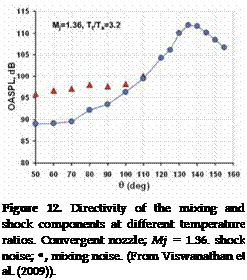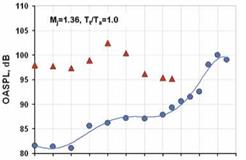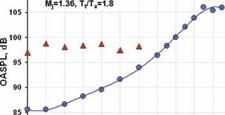Screech Tones
Powell (1953b), Powell (1953c) was the first to perform detailed investigations of screech tones from model scale supersonic jets. Powell’s experiments from convergent nozzles revealed that the wavelengths of the screech tones increased with increasing NPR and that the tone radiated preferentially in the upstream direction. A two-dimensional nozzle exhibited a smooth variation of screech wavelengths with pressure ratio, while an axisymmetric nozzle had discontinuous frequency (and corresponding wavelength) jumps with increasing NPR. He attributed the tone generation phenomenon to a feedback mechanism. Davies and Oldfield (1962) showed that the various screech modes of an axisymmetric nozzle were not disjoint but actually overlapped, indicating that several modes could co-exist or that the preference for a particular mode switched randomly back and forth. Many investigators have studied the screech phenomenon since then. For example, Hammitt (1961), Westley and Woolley (1969), Westley and
|
|
|
110 |
 |
|
|
|
80 —– 1— 1— 1— 1— 1— 1— 1— 1— 1— 1— 1 |
Woolley (1975), Rosfjord and Toms (1975), Sherman et al. (1976), and researchers at the NASA Langley Research Center, including Norum (1983) and Seiner (1984), are just a few references. Raman (1998), Raman (1999) has provided an extensive list of references.
The discrete screech tones can be of high intensity depending on the nozzle operating conditions and geometry. Usually, these tones are more pronounced for cold jets, with the amplitude of screech decreasing with increasing jet temperature. As the jet temperature is increased at a fixed Mach number, the screech frequency increases. The frequency of screech is independent of observer angle, indicating that the source of screech is spatially stationary. Simultaneous multiple screech modes are generally observed at most jet operating conditions. Figure 13, from Seiner (1984), shows the screech modes as a function of jet Mach number. This figure is a compilation of various experimental measurements of screech tones obtained with a convergent nozzle and an unheated jet. The round jet exhibits a staging phenomenon when the Mach number is increased, with jumps in the screech frequency. Optical observations have revealed that the different screech modes are associated with different oscillatory modes of the jet plume. These are either toroidal or helical mode instabilities. At lower Mach numbers, the toroidal large-scale instabilities are dominant, while the helical modes become dominant above a Mach number of approximately 1.3. Flow visualizations by Seiner et al. (1986), among others, have shown that the left and right hand helical disturbances are excited simultaneously, causing the jet to flap up and down. However, the azimuthal orientation of the flapping plane is not constant and has been found to precess for as yet unknown reasons. As seen in Figure 13, more than one mode may be present at a given Mach number. However, these tones are not harmonics of each other. As the jet Mach number is increased, the wavelength of the screech increases until a critical value is reached, beyond which a marked jump in wavelength occurs. For the Mach number range of 1.1 to 1.8, more than five modes or stages, labeled A1, A2, B, C, D and E in Figure 13 have been observed. These tones are very sensitive to the details of the experimental facility and not all modes are observed in any individual facility.
In summary, the screech generation mechanism is strongly dependent on upstream geometry. In commercial engines, the nozzle geometry is seldom perfectly axisymmetric. For realistic hot engine flows, screech is not considered to be a problem at all. However, high tone levels have been measured in military aircraft with closely spaced engines. For such aircraft (F-15 and the B1-B), sonic fatigue and structural failure of upstream aircraft components is a concern. The early work of Hay and Rose (1970) showed clearly that significant noise amplitudes around the screech frequency could
|
Figure 13. Variation of fundamental screech tone wavelength with Mach number for various stages of screech. Convergent nozzle and unheated flow. (From Seiner (1984), with permission). |
be present for some engine conditions and geometries. As the flight altitude increased, the nozzle operated at supersonic conditions due to the decrease in ambient static pressure. Consequently, high tone levels were observed at cruise. Prolonged exposure to the high dynamic loads, when there was a matching of the screech frequency and that of the structural modes caused structural damage. Seiner et al. (1987) investigated the screech characteristics and the plume dynamics of twin supersonic jets using axisymmetric C-D and rectangular nozzles. The study revealed that when two adjacent supersonic nozzles have a centerline spacing less than two nozzle diameters, the axial evolution of each nozzle plume’s preferred shear layer instability wave was coupled. This coupling process stimulated an axially synchronized and enhanced growth of each plume’s preferred spatial instability. Under these conditions, the dynamic pressure in the inter-nozzle region was found to be significantly higher than would be expected from two uncoupled supersonic jets. In some instances, the amplitude was found to exceed the design loads for the structure. This study also showed that the staging phenomenon observed for the convergent nozzle was not as prevalent as for the single C-D nozzle. Even when several modes existed simultaneously, only one mode was dominant, with a significantly higher amplitude. At lower Mach numbers, when the nozzle was operated in an overexpanded state, the axisymmetric screech mode was dominant. In the underexpanded state (higher Mach numbers), the helical mode was found to be dominant.














